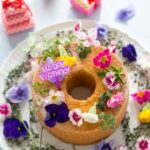Are you looking to take your cake decorating to the next level? Silicone cake decorating molds may be just what you need.
In this article, we will explore the world of silicone cake decorating molds and provide valuable tips and techniques on how to use them effectively to create stunning and professional-looking desserts. Whether you’re a seasoned pastry chef or a beginner baker, understanding the benefits and proper use of these versatile tools can elevate your cake decorating game.
Silicone cake decorating molds are becoming increasingly popular among bakers and pastry chefs for several reasons. Not only are they durable and easy to clean, but they also come in a wide variety of shapes, sizes, and designs, allowing for endless creative possibilities.
With their flexibility and non-stick properties, silicone molds make it easier to create intricate designs and decorations that would be challenging with traditional methods. From simple geometric shapes to elaborate floral patterns, silicone molds offer an array of design options that can take your cakes from ordinary to extraordinary.
When it comes to using silicone cake decorating molds, understanding how to properly prepare them is crucial for successful baking and decorating. Cleaning and prepping the molds before use ensures that they are free from any residue or contaminants that could affect the final product.
Additionally, choosing the right mold for specific cake decorating needs is essential for achieving the desired results. In the following sections, we will delve deeper into the different types of silicone molds available, as well as step-by-step instructions on preparing and using them for baking and decorating cakes.
Types of Silicone Cake Decorating Molds
Silicone cake decorating molds come in a wide variety of shapes, sizes, and designs, making them a versatile tool for bakers and pastry chefs. Whether you are looking to create floral patterns, geometric shapes, or intricate details for your cakes and desserts, there is a silicone mold to suit every need.
One of the benefits of silicone cake decorating molds is their flexibility, which allows for easy removal of the finished product without damaging the design. Additionally, these molds are non-stick, making it effortless to release the cake or dessert once it’s set. This makes silicone molds an ideal choice for intricate and delicate designs that may be challenging to achieve with traditional metal or plastic molds.
When choosing a silicone cake decorating mold, consider the size and shape you require for your specific baking needs. Some molds are designed for individual portions, while others may be larger and suitable for multi-layered cakes. Additionally, there are molds available in various themes such as holidays, weddings, or birthdays, allowing you to customize your creations according to the occasion.
To use silicone cake decorating molds effectively, it is essential to select the right mold that matches your desired design and follow proper techniques in preparing and using them. Understanding the different types available will help bakers and pastry chefs elevate their baking skills and creativity when using silicone molds for cake decorating.
By selecting the appropriate mold for your specific needs and learning how to use them effectively through this article’s guidance on selecting molds best suited for your design requirements.
Preparing the Silicone Cake Decorating Molds
Tips for Properly Cleaning and Prepping the Molds
Before using silicone cake decorating molds, it is essential to ensure that they are thoroughly cleaned and prepped. To clean the molds, wash them with warm soapy water and rinse them well to remove any traces of soap. You can also use a non-abrasive sponge to gently scrub the molds and remove any residue or contaminants that may be present. Once they are clean, allow the molds to air dry completely before using them.
Ensuring the Molds Are Free From Residue or Contaminants
After cleaning the silicone cake decorating molds, it is important to inspect them carefully to make sure there are no leftover residue or contaminants. Any particles left behind can impact the final design of your cakes or desserts, so it’s crucial to take the time to ensure they are completely clean.
Additionally, double-check for any signs of damage such as cuts or tears that could affect the quality of your baked goods. By thoroughly inspecting and preparing the silicone molds before use, you can avoid potential issues and ensure that your cakes turn out as intended.
Importance of Properly Preparing Silicone Molds
Properly preparing your silicone cake decorating molds is key to achieving the best results when baking and decorating your desserts. By following these tips for cleaning and prepping your molds, you can set yourself up for success in creating beautifully designed cakes and other treats. Taking the time to prepare your silicone molds will not only ensure a flawless finished product but also extend the lifespan of your baking tools.
Using Silicone Cake Decorating Molds for Baking
Silicone cake decorating molds are a versatile and popular choice for bakers and pastry chefs, offering a range of benefits. They are non-stick, flexible, and easy to clean, making them perfect for creating intricate designs and decorations on cakes and other desserts. Whether you are a beginner or an experienced baker, learning how to use silicone cake decorating molds for baking can elevate your creations to the next level.
Here are some step-by-step instructions on how to use silicone cake decorating molds for baking:
1. Choose the right mold: When using silicone cake decorating molds for baking, it’s important to select the right shape and size for your specific needs. Whether you’re making a simple round cake or a more elaborate design, there are plenty of options available.
2. Prep the mold: Before using the silicone mold, make sure to properly clean it and remove any residue or contaminants. This will ensure that your cakes come out looking perfect every time.
3. Fill the mold: Once your mold is prepped, pour in the batter with the correct consistency. It’s important not to overfill the mold to avoid any spillage during baking.
4. Bake the cake: Place the filled silicone mold on a baking tray and follow the baking instructions for your recipe. Keep an eye on the cake through the oven window so you can monitor its progress.
By following these simple steps, you can create beautiful and professional-looking cakes using silicone cake decorating molds. The flexibility of these molds allows for intricate details and designs, making them a must-have tool for any baker’s kitchen.
Decorating Cakes With Silicone Molds
Techniques for Using Silicone Molds
When it comes to decorating cakes with silicone molds, there are several techniques that can be used to create beautiful and intricate designs. One popular method is to press fondant or gum paste into the mold, then carefully remove the molded shape and place it onto the cake. This allows for precise and detailed decorations that can elevate the overall appearance of the cake.
Another technique is to use chocolate or candy melts in the silicone molds. By allowing the melted chocolate to set in the mold and then gently removing it, bakers can create stunning embellishments such as flowers, hearts, or other shapes to adorn their cakes. These chocolate decorations can add a delicious and eye-catching element to any dessert.
Tips for Enhancing Design With Different Colors and Layers
To take cake decorating with silicone molds to the next level, consider using different colors and layers. Once the molded shapes have been created, bakers can use food coloring or edible paint to add vibrant colors and intricate details. Layering different shapes and colors can also create a visually stunning effect, adding depth and dimension to the cake’s design.
Additionally, using edible luster dust or shimmer powder on molded decorations can give them a touch of sparkle and elegance. This is particularly effective for special occasions such as weddings or birthdays where a bit of extra glamour is desired.
Experimenting With Unique Designs
One of the most exciting aspects of using silicone molds for cake decorating is the ability to create unique designs that truly stand out. Whether it’s intricate lace patterns, delicate floral arrangements, or fun geometric shapes, there are endless possibilities for creating distinctive and personalized cake decorations.
For beginners looking to experiment with different designs, starting with simple shapes and patterns is recommended. As confidence grows, bakers can advance to more elaborate designs and take inspiration from various sources such as nature, art, or even fashion trends. Ultimately, using silicone molds for cake decorating provides a platform for creativity and innovation in pastry arts.
Removing the Finished Cake From the Silicone Mold
After baking and decorating your cake using silicone molds, the next crucial step is to carefully remove the finished cake from the mold. Here are some tips on how to do it without damaging your beautifully designed dessert:
1. Allow the Cake to Cool: Before attempting to remove the cake from the silicone mold, make sure that it has completely cooled. This will help the cake firm up, making it easier to release from the mold without losing its shape.
2. Gently Press and Peel: Once your cake has cooled, gently press on the sides of the silicone mold to release any air pockets around the edges of the cake. Then, carefully peel back the sides of the mold to release the cake.
3. Use a Flat Surface: Place a flat surface, such as a cutting board or serving platter, on top of the silicone mold with one hand while holding onto both surfaces with your other hand. Then, swiftly and carefully flip over both surfaces so that now the mold is on top and you can then gently lift off of it slowly.
4. Clean and Store Your Mold: After successfully removing your cake from the silicone mold, be sure to clean it thoroughly with warm water and mild dish soap before storing it for future use.
By following these simple steps, you can easily remove your finished cake from silicone molds without compromising its design or structure. Now you can confidently create stunning desserts using silicone molds for all your special occasions.
Troubleshooting Common Issues With Silicone Cake Decorating Molds
Silicone cake decorating molds are a versatile and convenient tool for creating beautifully detailed cakes and desserts. However, like any baking tool, they can come with their own set of issues. In this section, we will address some common problems that may arise when using silicone cake decorating molds and provide solutions to help overcome these challenges.
One common issue that bakers may encounter when using silicone cake decorating molds is the problem of sticking. This can occur when the mold is not properly prepped before use or when the cake batter has a high sugar content.
To prevent sticking, it is important to thoroughly grease the mold with non-stick cooking spray or a light layer of oil. Additionally, lightly dusting the mold with flour can also help create a barrier between the cake batter and the mold.
Another issue that may arise is the formation of air bubbles in the finished design. Air bubbles can detract from the overall appearance of the cake and disrupt intricate designs. To avoid air bubbles, carefully tap the filled silicone mold on a flat surface to release any trapped air before baking. It is also helpful to use a spatula to smooth out the batter and ensure it fills all crevices in the mold.
Uneven designs or distorted shapes are also common concerns when using silicone cake decorating molds. This can occur if the molds are not properly filled or if they are placed on an uneven surface in the oven. To ensure even designs, carefully fill each mold cavity with an even amount of batter, and place them on a level baking sheet before placing in the oven.
Addressing these common issues will ensure that your experience using silicone cake decorating molds is successful and enjoyable. With proper preparation and attention to detail, you can create stunning cakes and desserts that will impress everyone who sees them.
| Common Issue | Solution |
|---|---|
| Sticking | Thoroughly grease with non-stick cooking spray or oil; lightly dust with flour |
| Air Bubbles | Tap filled mold on flat surface to release trapped air; smooth out batter with spatula |
| Uneven Designs/ Distorted Shapes | Carefully fill each mold cavity evenly; place on level baking sheet in oven |
Creative Ideas for Using Silicone Cake Decorating Molds
In conclusion, silicone cake decorating molds are a versatile and convenient tool for bakers and pastry chefs to create stunning and intricate designs on their cakes and desserts. From simple shapes to detailed patterns, these molds offer a wide range of options for creative expression in the kitchen. By choosing the right mold for specific decorating needs and following proper preparation and usage techniques, anyone can achieve professional-looking results with ease.
When using silicone cake decorating molds, it’s important to carefully prepare the molds before use by cleaning them thoroughly and ensuring they are free from any residue or contaminants. Additionally, when baking with these molds, it’s crucial to use the right batter consistency and fill the molds properly to achieve the desired design. Furthermore, when removing the finished cake from the mold, it’s essential to do so carefully to avoid damaging the intricate design.
In addition to providing step-by-step instructions on how to use silicone cake decorating molds for baking and decorating cakes, this article also offers troubleshooting tips for common issues that may arise during the process. By arming themselves with this knowledge, bakers can confidently experiment with different designs and create beautiful desserts that are sure to impress. With practice and creativity, anyone can master the art of using silicone cake decorating molds to elevate their baking game.

Welcome to my blog about home and family. This blog is a place where I will share my thoughts, ideas, and experiences related to these important topics. I am a stay-at-home mom with two young children. I hope you enjoy reading it! and may find some helpful tips and ideas that will make your home and family life even better!





